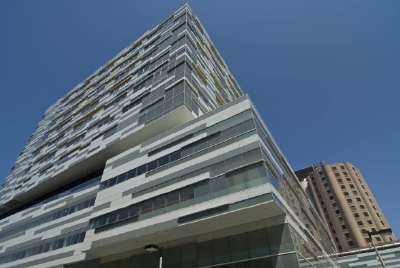Shapiro Center Doors Ready to Open

The grand opening of the Carl J. and Ruth Shapiro Cardiovascular Center and the transformation of care that it promises are upon BWH, with celebrations for staff, donors and members of the community underway and plans in place to move patients across Francis Street in June.
After four years of planning and construction, BWH expects to have the certificate of occupancy and the Massachusetts Department of Public Health approval for the newest addition to BWH’s main campus in early May. During the last two weeks of May and the first few weeks of June, several cardiovascular services will open in the new building.
“The Shapiro Cardiovascular Center will facilitate integration among related disciplines and revolutionize the care we deliver in a truly patient- and family-centered way,” said BWH President Gary Gottlieb, MD, MBA. “It will be the most advanced cardiovascular care facility in the world, enabling us to further treatment and discovery in the fight against heart disease.”
In April and May, BWH hosted and sponsored a number of events to celebrate the opening of Shapiro, including a tour for Massachusetts Gov. Deval Patrick and a dedication celebration with Boston Mayor Thomas Menino. BWH also sponsored a series of classes and screenings for patients and community members that focused on the latest in prevention and treatment of heart and vascular diseases in Boston, Brookline and Newton. In addition, BWH and HMS hosted nearly 50 referring physicians for a half-day CME program.
“This center will transform the care of cardiovascular patients here, and we hope it also will serve as a paradigm for the care of cardiovascular patients across the country,” said Kenneth Baughman, MD, director of the Advanced Heart Disease Section. “Patients will consult with a team of specialists, all under one roof, encouraging communication and promoting comprehensive care.”
The CME program provided referring physicians with a tour of the 350,000-square-foot building, which rises 10 stories above ground with 136 single-occupancy inpatient rooms, all of which are ICU-adaptable, on floors six through 10. The new facility features modern Pathology laboratories with the Center for Advanced Molecular Diagnostics, and 16 new ORs, increasing BWH’s total number of ORs from 39 to 44.

From left, Peter Libby, Kenneth Baughman, Michael Davidson and Marcelo Di Carli answer questions during the April 12 cardiovascular CME program at BWH.
During the CME, Peter Libby, MD, chief of Cardiology, presented on advances in understanding and managing cardiovascular risk; Marcelo Di Carli, MD, director of Cardiovascular Imaging and chief of Nuclear Medicine/PET, detailed advances in imaging and the changing paradigm of diagnosis and management of cardiovascular disease; Michael Belkin, MD, chief of Vascular and Endovascular Surgery, presented on the changing face of vascular surgery; Michael Davidson, MD, director of Endovascular Cardiac Surgery, detailed the latest advances in minimally invasive and percutaneous surgeries; and Gregory Couper, MD, surgical director for heart transplantation and circulatory assist programs, detailed BWH’s multidisciplinary team approach to caring for patients with advanced heart disease.
That patient-centered approach promises to be expanded upon with the Shapiro Center’s full range of cardiovascular services in a single building, better supporting communication among teams of specialists and staff to address each patient’s needs in an integrated, comprehensive manner. The operating rooms in the Shapiro Cardiovascular Center feature the latest technologies to support both interventional and surgical procedures.
The outpatient clinic rooms of the Watkins Cardiovascular Clinic are designed to accommodate cardiovascular care providers from all service lines. This streamlines the delivery of care for patients as they won’t have to travel to separate buildings for vascular services, for example. In addition, imaging and noninvasive imaging, including CT, Nuclear Medicine and stress echo will be in the same area to keep with the integrated model.
“The integrated nature of the center’s organization will allow BWH to promote discovery of new treatments, accelerate the translation of scientific research into proven clinical practices and train future leaders in cardiovascular medicine in these cutting-edge clinical and research disciplines,” said Joseph Loscalzo, MD, PhD, chair of the Department of Medicine and chair of the Cardiovascular Center of Excellence Leadership Committee.
The Shapiro Cardiovascular Center is also environmentally friendly. In fact, it likely will be the first hospital facility in New England to receive Leadership in Energy and Environmental Design, or LEED, certification. During the three-year construction schedule, contractors recycled more than 90 percent of construction waste and used recycled building materials when possible. Low-emitting adhesives, sealants, carpets and paints are in place throughout the facility. And more than 75 percent of interior spaces throughout the building are exposed to natural light. The roof is painted white to deflect heat.

Joseph O’Farrell, senior project manager, leads a tour of the Shapiro Center for referring physicians who attended the April 12 cardiovascular CME program at BWH.